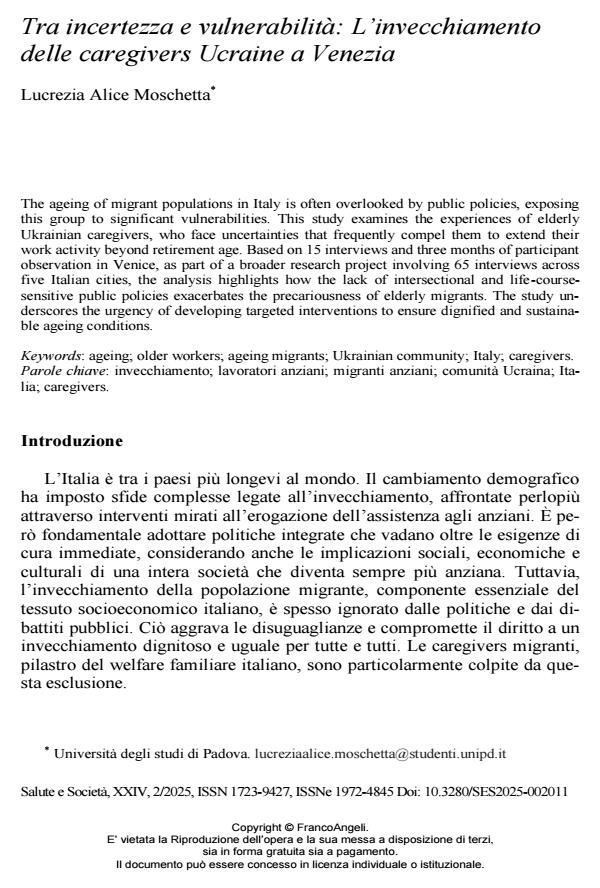Tra incertezza e vulnerabilità: L’invecchiamento delle caregivers Ucraine a Venezia
Journal title SALUTE E SOCIETÀ
Author/s Lucrezia Alice Moschetta
Publishing Year 2025 Issue 2025/2
Language Italian Pages 11 P. 129-139 File size 285 KB
DOI 10.3280/SES2025-002011
DOI is like a bar code for intellectual property: to have more infomation
click here
Below, you can see the article first page
If you want to buy this article in PDF format, you can do it, following the instructions to buy download credits

FrancoAngeli is member of Publishers International Linking Association, Inc (PILA), a not-for-profit association which run the CrossRef service enabling links to and from online scholarly content.
The ageing of migrant populations in Italy is often overlooked by public policies, exposing this group to significant vulnerabilities. This study examines the experiences of elderly Ukrainian caregivers, who face uncertainties that frequently compel them to extend their work activity beyond retirement age. Based on 15 interviews and three months of participant observation in Venice, as part of a broader research project involving 65 interviews across five Italian cities, the analysis highlights how the lack of intersectional and life-course-sensitive public policies exacerbates the precariousness of elderly migrants. The study underscores the urgency of developing targeted interventions to ensure dignified and sustainable ageing conditions.
Keywords: ageing; older workers; ageing migrants; Ukrainian community; Italy; caregivers.
- Cvajner M. (2019). Soviet signoras. Personal and collective transformations in Eastern European migration. Chicago and London: The University of Chicago Press.
- Giammarinaro M.G., Palumbo L. (2021). Vulnerabilità situazionale, genere e diritti umani. Analisi della normativa e della giurisprudenza italiana e so¬vranazionale sullo sfruttamento lavorativo. In: Gioffredi G. et al., a cura di, Diritti umani in crisi? Emergenze, disuguaglianze, esclusioni. Firenze: Paci¬ni Giuridica.
- Gilodi A., Albert I., Nienaber B. (2022). Vulnerability in the context of migration: A critical overview and a new conceptual model. Human Arenas, 7: 620-640.
- Gubernskaya Z., Dobreva T. (2023). Older migrants and socio-economic inequalities. In: Torres S., Hunter A., editors, Handbook on Migration and Ageing. Edward Elgar Publishing.
- Hochschild A.R. (2000). Global care chains and emotional surplus value. In: Hutton W., Giddens A., editors, On the edge: Living with global capitalism. Jonathan Cape.
- Holman D., Walker A. (2021). Understanding unequal ageing: Towards a synthesis of intersectionality and life course analyses. European Journal of Ageing, 18(2): 239–255.
- Istat (2023). Cittadini non comunitari in Italia. Anni 2022-2023. -- Testo disponibile al sito: https://www.istat.it/it/files/2023/10/REPORT-CITTADINI-NON-COMUNITARI-2023.pdf (03/10/2024)
- Kapilashrami A., Hankivsky O. (2018). Intersectionality and why it matters to global health. Lancet, 391(10140): 2589–2591. DOI: 10.1016/S0140-6736(18)31431-
- Marchetti S., Venturini A. (2014). Mothers and grandmothers on the move: Labour mobility and the household strategies of Moldovan and Ukrainian migrant women in Italy. International Migration, 52(5): 111-126.
- Osservatorio Domina sul Lavoro Domestico (2023). 5° Rapporto annuale sul lavoro domestico: Analisi, statistiche, trend nazionali e locali. Testo disponibile al sito: https://www.osservatoriolavorodomestico.it/rapporto-annuale-lavoro-domestico-2023 (28/01/2025)
- Redini V., Vianello F. A., Zaccagnini F. (2020). Il lavoro che usura. Migrazioni femminili e salute occupazionale. Milano: Franco Angeli.
- Repetti M. (2023). Retirement. In: Torres S., Hunter A., editors, Handbook on Migration and Ageing. Edward Elgar Publishing.
- Vianello F.A. (2009). Migrando sole. Legami transnazionali tra Ucraina e Italia. Milano: Franco Angeli.
Lucrezia Alice Moschetta, Tra incertezza e vulnerabilità: L’invecchiamento delle caregivers Ucraine a Venezia in "SALUTE E SOCIETÀ" 2/2025, pp 129-139, DOI: 10.3280/SES2025-002011